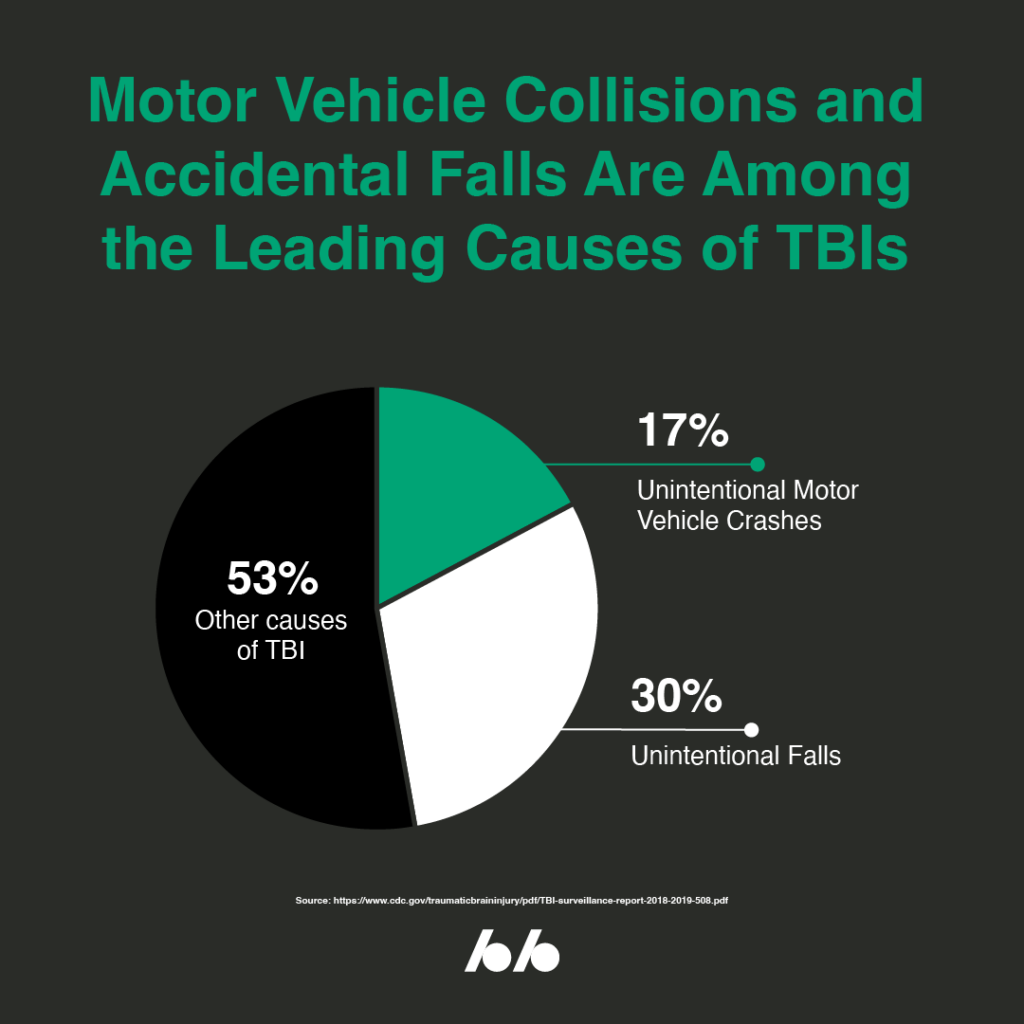Posted At: Oct 06, 2023 - 586 Views


We see a lot of different types of injuries as a P.I. firm in Phoenix, Arizona, but traumatic brain injuries (TBI’s) can be some of the most devastating for victims and their families. You rely heavily on your brain for both physical and mental functions that allow you to participate in all the wonderful things that make life so enjoyable. Even the most common types of TBI can put your quality of life at risk in a way that is worth seeking compensation for, especially when the cause comes from the hands of another party.
Learn what we mean by a TBI injury, the impact it can have on your life, and how a personal injury attorney may be of value in your recovery process.
What Are the 8 Common Types of TBI?
Traumatic brain injuries include a variety of conditions that result from trauma (i.e., a collision or other event that alters the brain). Generally, a TBI is either open or closed, depending on if there was any penetration of the skull. Below are the eight most common types of TBI:
- Concussions
- Contusions
- Intracranial hemorrhages
- Intracranial hematomas
- Coup-contrecoup brain injury
- Diffuse axonal injury
- Penetrating brain injury
- Second impact syndrome
The Most Common Types of TBI
Concussions are the most common type of TBI and account for approximately 3 out of 4 TBI’s yearly, according to the Cleveland Clinic. In best-case scenarios, they are the least severe type of TBI, but can become more dangerous in extreme cases or if you suffer from multiple concussions. Symptoms of concussions may include a brief loss of consciousness and feelings of confusion that persist over a day. You may also have trouble with focusing or with your memory retention.
Concussions are the most common types of TBI and account for 3 out of every 4 traumatic brain injuries.
How is The Severity of a TBI Determined?
Medical professionals and brain injury specialists will use various methods to assess and diagnose the severity of a TBI. These methods include:
- Measuring the duration of the patient’s loss of consciousness (if any)
- Seeing if the patient shows any sign of posttraumatic amnesia or confusion
- Reviewing the results of neuroimaging scans (e.g., a CAT scan or an MRI)
- Looking at the patient’s score on the Glasgow Coma Scale (GCS)
The GCS and How It Rates the Types of TBI
The GCS is a framework for evaluating the seriousness of a TBI through a scoring system that measures critical functions like eye opening, verbal response, and motor response. GCS scales from a score of 15 to 1, with a lower score indicating a more serious brain injury. The GCS then divides the 1-15 scoring scale into three grades that further reflect the severity of the TBI and allow medical staff to properly monitor the improvement or worsening of the injured person’s condition.
The 3 Grades of TBI
The three grades of traumatic brain injury include:
- Mild: This grade reflects injuries like minor concussions where you only experience a brief loss of consciousness and other temporary effects (e.g., dizziness, confusion, etc.).
- Moderate: Loss of consciousness is longer-lasting (i.e., 30 minutes or more), and other side effects also have a longer duration compared to a mild TBI.
- Severe: Your loss of consciousness lasts more than a day, and neuroimaging will likely confirm alterations to the brain (e.g., bleeding or swelling).
Traumatic brain injuries are either mild, moderate, or severe, depending on the result of a GCS test and other factors.
What Is an Intracranial Hemorrhage?
An intracranial hemorrhage is a formal term for bleeding into the brain tissue, which can cause damage to the brain and create pressure inside the skull. For example, intracranial hemorrhage is a common cause of stroke.
The 4 Types of Intracranial Hemorrhages
Not all intracranial hemorrhages are the same, and doctors generally distinguish them into four different types based on where the bleeding occurs in the brain and its nature. The four types are:
- Epidural Hematoma: A bleed that can arise via artery or vein, and generally occurs with the meningeal artery after a skull fracture or blunt trauma to the head.
- Subdural Hematoma: When blood enters the subdural space, usually after the blood vessel between the brain and skull either stretches or tears.
- Subarachnoid Hemorrhage: Classified as any bleeding into the subarachnoid that doctors will further classify depending on if the hemorrhage is traumatic versus non-traumatic and aneurysmal versus non-aneurysmal.
- Intraparenchymal Hemorrhage: Any bleeding into the parenchyma proper, which can come from a variety of causes such as infection, hypertension, aneurysm rupture, or a tumor.
Symptoms and Causes of Intracranial Hemorrhages
Common signs and symptoms that you may be experiencing an intracranial hemorrhage could include:
- Weakness or numbness on one side of your body (similar to stroke symptoms)
- Seizures
- Headaches
- Nausea
- Vision loss or loss of consciousness
Many different factors can cause or contribute to the onset of an intracranial hemorrhage. Some causes may relate to your family and medical history (e.g., prior history of stroke, age, race, gender, etc.). Other causes could be hypertension, drug and alcohol use, or other brain conditions like a tumor or infection. Of course, trauma from an external source could also lead to brain bleeds, such as a fall or collision.

How Can a Moderate or Severe TBI Impact Your Life?
More serious traumatic brain injuries can have some of the most damaging and long-lasting impacts on a person’s life. Depending on the severity, you may never fully recover from the injury and live the life you had before the accident. The most harmful impacts can include diminished mental capacity, paralysis, reduced motor function, and even death. Besides affecting your health, a TBI may negatively affect your social life and relationship with your spouse, family, and friends. It may also limit your ability to continue in your line of work and earn a living.
TBI’s can have many negative impacts on your life, affecting your mental and physical abilities in a way that interferes with your family, work, and quality of life.
Is There a Link Between TBI and Spinal Cord Injuries?
The physical connection between your brain and spine means that a link can exist between TBI and spinal cord injuries. Depending on the source of the trauma for the injury, it’s possible to have both a TBI and spinal cord injury, especially where the two parts of the body meet at the neck area.

Why Is It Important to Hire an Attorney After a TBI?
As explained above, traumatic brain injuries can have a negative and permanent effect on a person’s quality of life. Recovery can be long and not guaranteed. Although disability benefits may be available, you might not be able to work and sustain the income you were accustomed to before the TBI. Depending on the nature of your injury, you might have legal recourse options through insurance or a lawsuit against any party responsible for causing your brain injury.
A personal injury attorney can help you evaluate possible TBI-related legal claims and provide guidance throughout the entire litigation process toward recovery and compensation.
Working with an attorney may provide you with several key benefits when trying to receive owed compensation for your TBI. An attorney could be helpful in all steps of the process, from identifying liable parties, gathering evidence, advising on settlement options, and advocating for you at trial, if necessary. Personal injury cases involving catastrophic injuries like TBI can be complex and highly litigious because of the seriousness of the injury and the potential damages at stake. Having an experienced attorney on your side can help you better understand your rights and make informed decisions for your recovery.
Meet With Our Attorneys About Your TBI Personal Injury Case Today
We are a personal injury litigation law firm with offices throughout the state of Arizona. Our attorneys at Top’s Injury Law Group represent injured parties in all types of legal actions involving different types of traumatic brain injury and other serious bodily harms that result from accidents such as those caused by motor vehicles, slips and falls, and other catastrophes. We handle every aspect of the litigation claim and do our best to take an aggressive approach that centers around the goals of our client – whether that be a fast settlement or seeking justice at trial.
Schedule a free consultation to speak about your traumatic brain injury case with our attorneys by calling (480) 470-2299.
